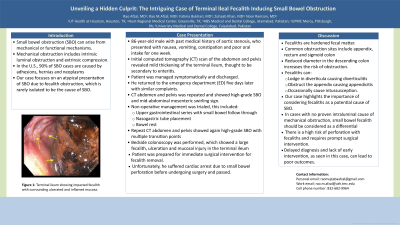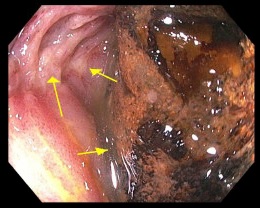Sunday Poster Session
Category: Small Intestine
P1532 - Unveiling a Hidden Culprit: The Intriguing Case of Terminal Ileal Fecalith Inducing Small Bowel Obstruction
Sunday, October 27, 2024
3:30 PM - 7:00 PM ET
Location: Exhibit Hall E

Has Audio

Rao Afzal, MD
University of Pittsburgh Medical Center - Mercy
Pittsburgh, PA
Presenting Author(s)
Rao Afzal, MD1, Rao Mustafa Afzal, MD2, Fatima Bukhari, MBBS3, Zuhaab U. Khan, MD1, Noor Ul Huda Ramzan, MD4
1University of Pittsburgh Medical Center - Mercy, Pittsburgh, PA; 2Hunt Regional Healthcare, Greenville, TX; 3Hazrat Bari Sarkar Medical and Dental College, Islamabad, Islamabad, Pakistan; 4University Medical and Dental College, Pittsburgh, PA
Introduction: Small bowel obstruction (SBO) is due to a mechanical or functional mechanism. Mechanical obstruction includes either intrinsic luminal obstruction or extrinsic compression. In the United States, 90% of cases are caused by adhesions, hernias, or neoplasms. Our case focuses on an atypical presentation of SBO secondary to a fecalith obstruction, since fecaliths are rarely found to cause an isolated SBO.
Case Description/Methods: 86-year-old male with aortic stenosis presented with nausea, vomiting, constipation, and poor oral intake for one week. Computed tomography (CT) of the abdomen showed mild thickening of terminal ileum which was thought to be secondary to enteritis. He was symptomatically managed and discharged. He returned five days later with similar complaints and a repeat CT scan revealed a high-grade SBO with mid-abdominal mesenteric swirling sign. The patient was trialed on non-operative management which included upper gastrointestinal series with small bowel follow through, nasogastric tube placement and bowel rest. Contrast appeared in the colon in 4-6 hours. He later underwent another repeat CT scan which redemonstrated a high-grade SBO with multiple transition points. Given failure to progress, a bedside colonoscopy was pursued, revealing a large fecalith with ulceration and mucosal injury in the terminal ileum. The patient was prepped for immediate surgical intervention for fecalith removal. In the interim, he suffered cardiac arrest in the setting of small bowel perforation. Due to hemodynamic instability, he was unable to undergo emergent surgery and expired.
Discussion: Fecaliths are hardened pieces of fecal matter and the most common sites of obstruction include the appendix, rectum, and sigmoid colon. A reduced diameter in the descending colon leads to an increased propensity for obstruction. Fecaliths can lodge within diverticula and cause diverticulitis, obstruct the appendix and cause appendicitis and at times cause intussusception. When no proven intraluminal cause of mechanical obstruction is encountered, a small bowel fecalith should be considered in differentials since it carries a high risk of small bowel perforation requiring prompt surgical intervention. As in the case of our patient, a delayed diagnosis and absence of early intervention led to a poor outcome.

Disclosures:
Rao Afzal, MD1, Rao Mustafa Afzal, MD2, Fatima Bukhari, MBBS3, Zuhaab U. Khan, MD1, Noor Ul Huda Ramzan, MD4. P1532 - Unveiling a Hidden Culprit: The Intriguing Case of Terminal Ileal Fecalith Inducing Small Bowel Obstruction, ACG 2024 Annual Scientific Meeting Abstracts. Philadelphia, PA: American College of Gastroenterology.
1University of Pittsburgh Medical Center - Mercy, Pittsburgh, PA; 2Hunt Regional Healthcare, Greenville, TX; 3Hazrat Bari Sarkar Medical and Dental College, Islamabad, Islamabad, Pakistan; 4University Medical and Dental College, Pittsburgh, PA
Introduction: Small bowel obstruction (SBO) is due to a mechanical or functional mechanism. Mechanical obstruction includes either intrinsic luminal obstruction or extrinsic compression. In the United States, 90% of cases are caused by adhesions, hernias, or neoplasms. Our case focuses on an atypical presentation of SBO secondary to a fecalith obstruction, since fecaliths are rarely found to cause an isolated SBO.
Case Description/Methods: 86-year-old male with aortic stenosis presented with nausea, vomiting, constipation, and poor oral intake for one week. Computed tomography (CT) of the abdomen showed mild thickening of terminal ileum which was thought to be secondary to enteritis. He was symptomatically managed and discharged. He returned five days later with similar complaints and a repeat CT scan revealed a high-grade SBO with mid-abdominal mesenteric swirling sign. The patient was trialed on non-operative management which included upper gastrointestinal series with small bowel follow through, nasogastric tube placement and bowel rest. Contrast appeared in the colon in 4-6 hours. He later underwent another repeat CT scan which redemonstrated a high-grade SBO with multiple transition points. Given failure to progress, a bedside colonoscopy was pursued, revealing a large fecalith with ulceration and mucosal injury in the terminal ileum. The patient was prepped for immediate surgical intervention for fecalith removal. In the interim, he suffered cardiac arrest in the setting of small bowel perforation. Due to hemodynamic instability, he was unable to undergo emergent surgery and expired.
Discussion: Fecaliths are hardened pieces of fecal matter and the most common sites of obstruction include the appendix, rectum, and sigmoid colon. A reduced diameter in the descending colon leads to an increased propensity for obstruction. Fecaliths can lodge within diverticula and cause diverticulitis, obstruct the appendix and cause appendicitis and at times cause intussusception. When no proven intraluminal cause of mechanical obstruction is encountered, a small bowel fecalith should be considered in differentials since it carries a high risk of small bowel perforation requiring prompt surgical intervention. As in the case of our patient, a delayed diagnosis and absence of early intervention led to a poor outcome.

Figure: Terminal ileum showing impacted fecalith with surrounding ulcerated and inflamed mucosa.
Disclosures:
Rao Afzal indicated no relevant financial relationships.
Rao Mustafa Afzal indicated no relevant financial relationships.
Fatima Bukhari indicated no relevant financial relationships.
Zuhaab Khan indicated no relevant financial relationships.
Noor Ul Huda Ramzan indicated no relevant financial relationships.
Rao Afzal, MD1, Rao Mustafa Afzal, MD2, Fatima Bukhari, MBBS3, Zuhaab U. Khan, MD1, Noor Ul Huda Ramzan, MD4. P1532 - Unveiling a Hidden Culprit: The Intriguing Case of Terminal Ileal Fecalith Inducing Small Bowel Obstruction, ACG 2024 Annual Scientific Meeting Abstracts. Philadelphia, PA: American College of Gastroenterology.
